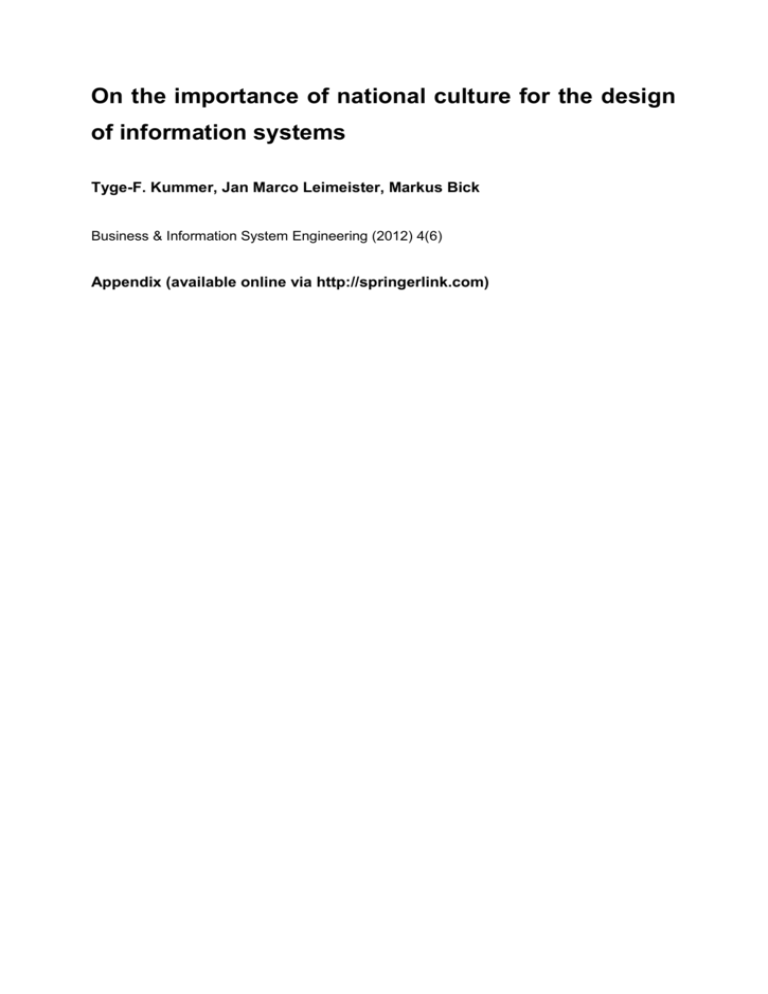Appendix A - Springer für Professionals
advertisement

On the importance of national culture for the design of information systems Tyge-F. Kummer, Jan Marco Leimeister, Markus Bick Business & Information System Engineering (2012) 4(6) Appendix (available online via http://springerlink.com) Appendix A Table 1-A Overview of the identified articles Reference Element of the regulatory framework Considered countries Data collection technique Data analysis technique Findings Arnott et al. (2007) Not classifiable Thailand Questionnaire and interviews (no number provided), document analysis Empirical-qualitative, case study analysis (4 projects) Avison and Malaurent (2007) Members, role/structure, technology France, China Interviews, observation Empirical-qualitative, case study analysis Carugati et al. (2005) Task, technology Greece, Italy, Denmark, France, United Kingdom, Ireland, Spain, Sweden Non-empirical Not included (conceptual) Task Australia, Korea Questionnaire (n=121) Empirical-quantitative, variance analysis The development of management information systems (MIS) in emerging markets is significantly influenced by the cultural fit. Critical success factors for project success are social and cultural aspects, the development method and the general cultural fit of the MIS. Cultural aspects influence the success of the implementation of ERP systems. Major areas of concern that often lead to project failure in China are language and communication behavior, economic and structural differences as well as political and legal issues. A framework is developed based on IDEF0, which supports the development of e-services in terms of e-government web sites. It aims at preserving cultural heritage within the European Union by defining resources, rules and goals for each activity. There are cultural differences regarding functionality requirements of information systems, which should be considered in the design of information Level of the design object Choe (2004) Cyr (2008) Members USA, Canada, Germany, Japan Questionnaire (n=114) Empirical-quantitative and analysis of variance (confirmatory) Davison et al. (2003) Task Silk road region (including Turkey, Kazakhstan, Turkmenistan, India, Nepal and China) Non-empirical Not included (conceptual) Garcia-Barriocanal et al. (2005) Task, technology Spain Non-empirical Not included (conceptual) Kersten et al. (2000) Members, role/structure General Non-empirical Not included (conceptual) systems. Korean companies require more non-financial types of information while Australian companies demand flexibility and quality performance as well as advanced cost control information. There are culturally related preferences in the design of websites. Of particular relevance to online shopping are trust, satisfaction and e-loyalty. While results of the Western countries are very similar, substantial differences with Japan were identified. E-commerce options are presented along the former silk road in the region of eastern China and central Asia (Kazakhstan). Barriers to infrastructure are presented along with cultural and economic problem areas to support the development of appropriate systems. The paper depicts the design of an ontology of humor artifacts that provides semantic access to current Spanish graphic humor. The semantic framework and the annotation technique support the preservation of cultural heritage through the development of appropriate systems. Software is produced in accordance with the requirements of the markets and therefore adapts to cultural values. At the same time, software influences the behavior and organizational principles Leimeister et al. (2009) Loebbecke and Thaller (2005) Martinsons and Ma (2009) Members, role/structure, technology Germany, Italia Questionnaire (n=620) Empirical-quantitative, structural equation modeling (PLS) (confirmatory) Task, technology Europe (in particular Germany) Non-empirical Not included (conceptual) Members, role/structure China and Chinese sub-cultures Questionnaire (n=1.104) Empirical-quantitative analysis of variance (exploratory) and thus culture. Therefore, a research agenda is developed which focuses on the interactions between software and culture. CIOs attribute different strategic importance to RFID in different cultures. While in Germany people are rather aiming at quality improvements, automation, and reducing counterfeiting, in Italy the reduction of stock inconsistencies and the optimization of stock keeping are more important. These differences may influence the development of corresponding systems. By introducing "Digital Autonomous Cultural Objects (DACOs)", a reference architecture is presented that enables global integration and institutional independence at the same time. DACO makes it possible to preserve the European cultural heritage in the digital. The approach is illustrated on the basis of two projects. Various national subcultures exist in China, which differ in terms of information ethics across managers. Significant differences between the Western morality, the traditional, and the modern Chinese culture are identified. The study questions the approaches proposed by Hofstede and the GLOBE study which assume “one” Monod and Klein (2005) Task, technology General (in particular Greece) Non-empirical Not included (conceptual) Motwani et al. (2007) Task, technology India, USA Interviews (no number provided) Empirical-qualitative, case study analysis (2 projects, exploratory) Shanks et al. (2000) Task, technology Australia, China Interviews (no number provided ), document analysis Empirical-qualitative, case study analysis (two projects, exploratory) Zahedi et al. (2006) Members, role/structure General Document analysis (90 websites and 550 phrases) Document-based qualitative, grounded theory (exploratory) Chinese culture. An "interpretive archeology system" is introduced, which meets the requirements for interactive interpretation support systems for cultural heritage. In addition, a framework for the evaluation of communication concerning cultural heritage is presented. The underlying approach is illustrated by a sample. Success factors in the implementation of ERP systems vary across cultures. Most important are differences in leadership styles and the depth of integration of external expertise. Cultural dimensions such as power distance partly explain these variations. Moreover, success factors like professional project management are important across cultures. Critical success factors in the implementation of ERP systems vary across different national cultures. National cultural dimensions like power distance partially explain these differences. In general, technical and training related aspects are more relevant in China, while in Australia project enthusiasm and change management are of crucial meaning. Considering cultural dimension of masculinity-femininity can improve the efficiency of web documents. Therefore, cultural content should be adapted to the values of the target audience. Otherwise, cultural messages can distort communication. Level of the design subject Akmanligil and Palvia (2004) Design technique, design goal General Interviews (no number provided) Empirical-qualitative, case study analysis (exploratory) Damian and Zowghi (2003) Design members Australia, USA Interviews (no number provided) Empirical-qualitative, case study analysis (exploratory) Deshpande et al. (2010) Design members Ireland, Italia Interviews (n=15) Empirical-qualitative, grounded theory (exploratory) Holmstrom et al. (2006) Design members Ireland Interviews (n=12) Empirical-qualitative, grounded theory (exploratory) Huang and Design members India, China, USA Interviews (n=38) Empirical-qualitative, case Nine strategies for the conduction of global IS development projects are identified. Moreover, a framework is developed that enables the selection of an appropriate strategy based on various parameters. Requirements management in global software development is affected by conflicts caused by cultural differences, inadequate communication, knowledge management, and time differences. Techniques for dealing with cultural differences in global software development are presented. Furthermore, it is demonstrated how these differences can be used as advantages. Temporal, geographical and sociocultural challenges for global software development are identified and possible solutions are derived. While the challenges are identical in the investigated companies, their solutions differ substantially. Near shoring is recommended as a general approach to deal with these challenges. Cultural differences in the perception of Trauth(2008) study analysis (exploratory) Hunter and Beck (2000) Design members Canada, Singapore Interviews (n=70) Other Kankanhalli et al. (2004) Design members Singapore, USA Questionnaire (n=211) Empirically-quantitative, structural equation modeling (PLS) (confirmatory) Keil et al. (2000) Design goal Finland, Netherlands, Singapore Experiment (n=536) Empirically-quantitative, structural equation modeling (PLS) (confirmatory) Keil et al. (2007) Design members Korea, USA Experiment (n=146) Empirical-quantitative analysis of variance (exploratory) time, hierarchical structure, relationship orientation and social commitments influence the temporal separation and coordination in globally distributed software development. With the Repertory Grid technique, an approach is presented to study culturally related differences between system analysts’ preferences for certain evaluation criteria. The approach is illustrated by identifying differences in assessment by a number of "excellent" systems analysts in two cultures. Cultural background and espoused values of IS developers are interrelated. Individualism / collectivism and masculinity / femininity influence technical, economic and socio-political values of developers. The failure of software development projects is differently judged in diverse cultures. Sunk costs and risk tendency of decision-makers are key drivers for decisions. This relationship appears to be stronger in countries with a high degree of uncertainty avoidance. If there are ways to blame others, the willingness to communicate bad news in software development projects increases significantly in the Unites States. In Korea, this effect could not be detected. Without the opportunity to blame others, no culturally based Kim and Peterson (2002) Design members, design goal Japan, USA Questionnaire (n=95) Empirical-quantitative, factor analysis, analysis of variance (exploratory) Peterson and Kim (2003) Design goal USA, Japan, Korea Questionnaire (n=310) Empirical-quantitative analysis of variance (confirmatory) Tan et al. (2003) Design members USA, Singapore Experiment (n=354) Empirical-quantitative analysis of variance (confirmatory) Walsham (2002) Design members General Case consideration Other differences between the two countries could be identified. According to the opinion of Japanese developers, the project leader is a key success factor for the development of IS. Team characteristics are regarded as less relevant. In contrast, developers from the United States consider the communication as the most critical aspect of development projects, while the characteristics of the project manager were considered as less important. The assessment of risk factors for development projects is influenced by culture. Developers in Japan and the USA identified similar risk factors, but these were different from factors identified by Korean developers. In Korea, inadequate experience, definitions of project objective and missed deadlines were given as reasons for IS development failures. In collectivist cultures, the decision to communicate bad news regarding a software project is primarily influenced by the organizational climate. In individualistic cultures, information asymmetries are of particular importance. Using structuration theory, a theoretical fundament is developed for explaining cross-cultural software development and Wende and Philip (2011) Design members Germany, India, Great Britain Interviews Empirical-qualitative, case study analysis (exploratory) Winkler et al. (2007) Design members Germany, India Interviews (n=9) Empirical-qualitative, case study analysis (exploratory) Yuan and Vogel (2006) Design members China Interviews (n=6) Empirical-qualitative, unspecified (exploratory) usage patterns. The underlying contribution is to be seen in contrast to Hofstede based approaches. It demonstrates how the developed approach can explain conflicts and contradictions, cultural heterogeneity, work patterns and the dynamic nature of culture. The usage of instant messengers as a tool to bridge cultural based power distance in software development is examined. Based on theoretical concepts of virtual teams, communication, media selection, cultural distance, and early warning systems potential benefits are illustrated. Differences between Germany and India in power distance, design understanding and work attitude were identified as critical success factors of outsourcing. Clear mechanism and role definition, strong leadership and an active cultural management – including the adaptation to the culture of the customer or supplier – are identified as effective management measures. The impact of Chinese national culture on the coordination among groups of software development is analyzed. It becomes clear that in particular collectivism and the fear of losing face determine the success factors of intergroup coordination. Connection between the design object and design subject Choi et al. (2005) Not classifiable Korea, Japan, Finland Interviews (n=24) Empirical-qualitative, unspecified (exploratory) Heumann et al. (2011) Not classifiable Germany, Austria, Switzerland Questionnaire (n=96) Empirical-quantitative, structural equation modeling (PLS) (confirmatory) Kaye und Little (2000) Not classifiable North East Asia, UK Non-empirical Literature-based qualitative, case studies analysis (exploratory) Kersten (2002) Not classifiable General Non-empirical Not included (conceptual) 52 attributes that are relevant to the use of mobile data services were identified, and 11 critical attributes that have a clear link to user culture. The results illustrate differences in the requirements between diverse cultures and emphasize the importance of critical design issues in the development of mobile data services. The national culture of supplier in IS Offshoring projects influences the degree of control provided to the customer. Differences are related to the cultural dimensions of power distance and time perception. Nevertheless, the influence of national culture of the supplier is comparatively low. Technology is being developed in a cultural context and thus includes culture in its design. For this reason, there are cultural conflicts in global software development and subsequently in the adoption by users. This paper points out the societal consequences for countries in various stages of development and with different cultural backgrounds. Cultural artifacts in e-business systems should be adjusted during the design of Kersten et al. (2002) Members, role/structure, design technique General Non-empirical Not included (conceptual) Moores and Gregory (2000) Not classifiable Far Eastern culture (especially Hong Kong) Interviews (no number provided) Empirical-qualitative, case study analysis (exploratory) Ravesteyn and Batenburg (2010) Members, role/structure, design members Northern Europe, Anglo-American culture Experiment and questionnaire (n=39) Empirical-quantitative, variance analysis (exploratory) the surface and the design of the software core. Two methods are presented: the extension of software localization beyond the interface and the utilization of emerging software design paradigms based on the meta-object orientation. As software applications are tailored to user interaction, it is not sufficient to adapt only the user interface to the existing culture. While the user interface should take the surface of culture into account, the software core needs to be adapted to the deep culture. It is shown how this can be realized in the modular way. Using Soft Systems Methodology (SSM) in software development causes three cultural problems: Group discussions are avoided, interviews are being conducted in multiple languages and – due to high staff turnover in management – taking a stakeholder perspective becomes almost impossible. The critical success factors for implementing business process management systems can be assigned to five culturally independent areas. However, the relevance of single factors differs significantly within these areas. Particularly in Northern Europe, intelligibility of the general concept, the processes and their relationship to each Saab (2008) Not classifiable General Non-empirical Not included (conceptually) other and a high management support are considered as important. A framework of cultural values related to information, technology, and people is developed. This can be used by information system developers to assess the “cultural geography” of the target audience in relation to their own. Appendix B Detailed Explanation of the research methodology In order to answer the questions mentioned in Sect. 1, a literature analysis was performed according to Webster and Watson (2002) applying the procedure of Buhl et al (2011). Since space limitations prohibit us from analyzing all relevant articles in detail, our literature review is based on a sample of research contributions published in accredited and well known journals and conference proceedings. In accordance with Buhl et al. (2011), the following databases were used to cover a wide field of different publications: AIS Electronic Library (Aisel), EBSCOhost, EmeraldInsight, IEEEXplore, INFORMS, InfoSci-Journals, Science Direct, SpringerLink and WileyInterscience. In addition, VHB JOUR QUAL, WI orientation lists and the Social Sciences Citation Index were consulted to ensure the scientific quality of publications. Because of their perfectly matching research focus, four articles published in the proceedings of the IEEE International Conference on Global Software Engineering were examined as well. The literature search was performed using the search fields "Title", "Abstract" and "Keywords". As our article examines to what extent cultural factors influence the design of information systems, the authors chose a combination of search terms consisting of a first part „Kultur“, „kulturell“ or „ländervergleichend“ and a second part „Design“, „Entwicklung“ or „Implementierung“ and their corresponding English translations. Table 2-B lists the combinations used in German and English. Table 1-B Criteria of the literature analysis (analogous to Buhl et al. 2011) Criteria Shaping Databases AIS Electronic Library (AISeL), EBSCOhost, EmeraldInsight, IEEEXplore, INFORMS, InfoSci-Journals, ProQuest, ScienceDirect, SpringerLink and WileyInterScience. Supplementary IEEE International Conference on Global Software Engineering Proceedings * Search fields Title, Summary, Keywords** Key phrases See Table 2-B Search period 1.1.2000- 30.6.2011 * If not included in other databases. ** If specifiable. 13 Table 2-B List of used keyword combinations Keyword combination (German) Keyword combination (English) „Kultur“ and „Design“ „Culture“ and „design“ „Kultur“ and „Entwicklung“ „Culture“ and „development“ „Kultur“ and „Implementierung“ „Culture“ and „implementation“ „Kulturell“ and „Design“ „Cultural“ and „design“ „Kulturell“ and „Entwicklung“ „Cultural“ and „development“ „Kulturell“ and „Implementierung“ „Cultural“ and „implementation“ „Ländervergleichend“ and „Design“ „Cross-cultural“ („cross cultural”) and „design“ „Ländervergleichend“ and „Entwicklung“ „Cross-cultural“ („cross cultural”) and „development“ „Ländervergleichend“ and „Implementierung“ „Cross-cultural“ („cross cultural”) and „implementation“ In order to sort out irrelevant articles the authors used a multi-stage approach (Buhl et al. 2011). Following Piccoli and Ives (2005), the selection of articles identified by the keywords was conducted in three steps. At first, 6314 papers were identified based on the keywords. After reading title and abstract, the authors decided whether an article provides an added value in terms of the framework (Sect. 2) and the defined research questions (Sect. 1). Subsequently, the selected contributions were read and analyzed in detail in order to decide again if they provide an added value for the present analysis. Table 3-B shows the results of the literature research with respect to the various databases (Buhl et al. 2011). After analyzing the abstract, 73 papers were retained. The number of papers retained after analyzing the abstract was 73, of which 39 papers were found to be relevant for the final analysis. Table 3-B Result in the databases Database AIS Electronic Library URL Results Analyzed (analyzed articles (full abstracts) text) http://aisel.aisnet.org 174 22 EBSCOhost http://search.ebscohost.com 213 8 EmeraldInsight http://www.emeraldinsight.com 1.894 5 IEEEXplore http://ieeexplore.ieee.org 351 8 INFORMS http://pubsonline.informs.org 514 4 ScienceDirect http://www.sciencedirect.com 520 13 SpringerLink http://www.springerlink.de 1.465 9 WileyInterScience http://www3.interscience.wiley.com 1.183 4 (AISeL) 14 Table 4-B illustrates the results after the last step of the article selection (Piccoli and Ives 2005). A total of 39 highly relevant articles were selected for the present study. Table 4-B Overview of the journal Journal Final selected papers Journal of Global Information Management (JGIM) 5 MIS Quarterly 2 IEEE Transactions on Engineering Management 1 Information Systems Research (ISR) 1 Information and Management 2 International Journal of Information Management 2 Decision Support systems 2 HMD - Praxis der Wirtschaftsinformatik 1 Information Systems Journal (ISJ) 1 WIRTSCHAFTSINFORMATIK 1 Journal of Management Information Systems (JMIS) 2 Journal of the Association of Information Systems (JAIS) 1 Sum of Journals: 21 Conference Proceedings European Conference on Information Systems 8 Hawaii International Conference on System Sciences (HICSS) 3 IEEE International Conference on Global Software Engineering 2 (ICGSE) Americas Conference on Information Systems (AMCIS) 2 International Conference on Information Systems (ICIS) 1 Tagungsband zur internationalen Tagung Wirtschaftsinformatik 1 (WI) Conference on Human Factors in Computing Systems (CHI) 1 Sum of Conference Proceedings: 18 Similar to the literature analysis of Buhl et al. (2011) and Piccoli and Ives (2005), it can be stated that due to the "[...] non representative data, not matching search terms or a too short time period the underlying database search could not detect all relevant sources and that the selection ultimately depends on the subjective judgment of the authors. " (Buhl et al., 2011, S. 162). On the other hand, this approach provides many benefits. These are among others a high degree of reproducibility and replication, intersubjective comprehensibility, the scope through which the specified criteria are delimited, and the lower likelihood of considering less 15 acclaimed publications (Buhl et al., 2011). Despite the fact that this procedure leads to a sample, rather than an exhaustive collection of literature, the authors believe that the benefits justify the choice for this approach. 16








